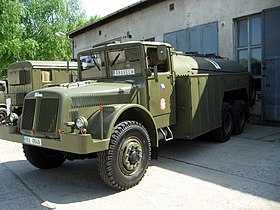Tatra T111
| Tatra 111 | |
|---|---|
 |
|
| Overview | |
| Manufacturer | Tatra |
| Production | 1942-1962 |
| Designer | Hans Ledwinka |
| Body and chassis | |
| Class | Heavy truck |
| Body style | Conventional |
| Related | |
| Powertrain | |
| Engine | See below |
| Transmission | 4-speed manual x 2-speed transfer case |
| Chronology | |
| Predecessor | Tatra 81 |
| Successor | Tatra 138 |
| Engine V910 | |
|---|---|
 |
|
| Overview | |
| Manufacturer | Tatra |
| Also called | V910 |
| Combustion chamber | |
| Configuration | 75° V12 |
| Displacement | 14.8 L (903 cu in) |
| Cylinder bore | 110 mm (4.3 in) |
| Piston stroke | 130 mm (5.1 in) |
| Cylinder block alloy | Cast iron |
| Valvetrain | OHV |
| Compression ratio | 16.5:1 |
| Combustion | |
| Fuel system | Direct injection 2x inline injection pumps 6 elements each |
| Fuel type | Diesel |
| Cooling system | Air-cooled |
| Output | |
| Power output | 180–210 hp (132.5 kW-158kW) @ 1800–2250 rpm |
| Torque output | 726 N·m (535 ft·lbf) @ 1400–1600 rpm |
The Tatra 111 was a truck produced in Czechoslovakia by the Tatra company.
The T111 was developed and manufactured during World War II as a heavy truck for use by the Wehrmacht. Production started in 1942 and continued for twenty years, ending in 1962 when it was replaced by the Tatra 138. Despite being built for the Nazi war machine, the vehicle ultimately played an important role after the war ended. The Tatra 111 contributed significantly to the rebuilding effort during the postwar era, mainly in Eastern Europe and the USSR. To its chief designer, however, it brought charges of treason and collaboration with the Nazi regime after the communist takeover of Czechoslovakia and contributed to the imprisonment of Tatra's design guru Hans Ledwinka.
The design was based on the proven Tatra concept of a backbone tube chassis construction with swing half axles, a modular gearbox and differential assemblies. The main advantages of the central load carrying backbone tube are its high torsion and bend strength, which protects the truck body against load stresses. The secondary advantage is that it houses all important parts of the drivetrain. Due to its torsional stiffness and use of differentials locks the vehicle had exceptional offroad capabilities. Of note was the ability to use a cranking handle to start the engine.
Model V910 - the first Tatra air-cooled powerplant V12 75-degree V developed from Tatra V850 engine intended for use in Tatra 103 (Sd Kfz. 234 Puma). The engines had power output of 210 horsepower at 2250 RPM mainly for war use (An average life expectancy during combat for Wehrmacht was 6 hours.) which was later reduced to 180 hp at 1800 rpm to increase reliability. The engine has three camshafts and originally was cooled by two covered chain-driven cooling fans and later belt drive (marked T111A).
...
Wikipedia
